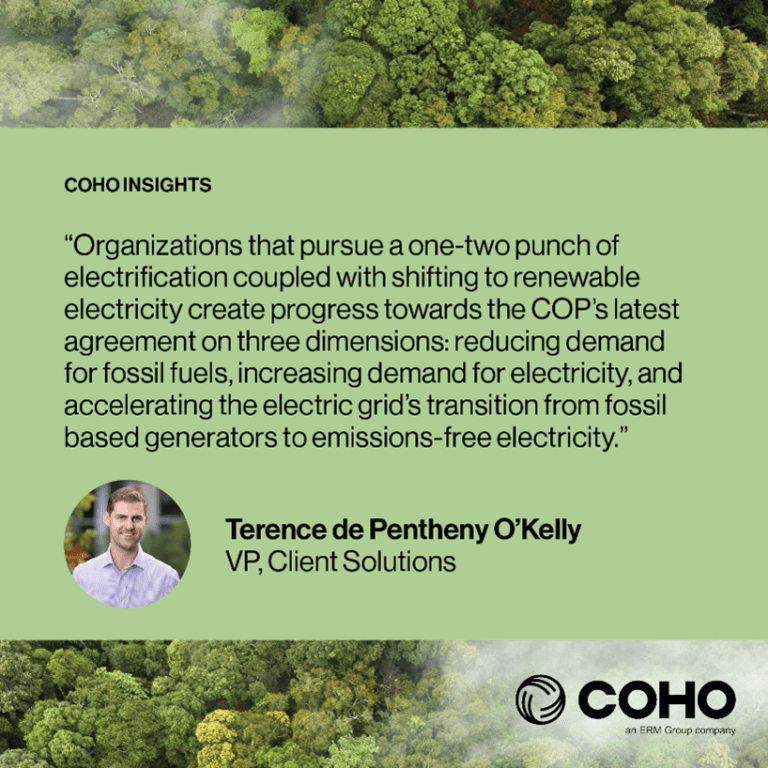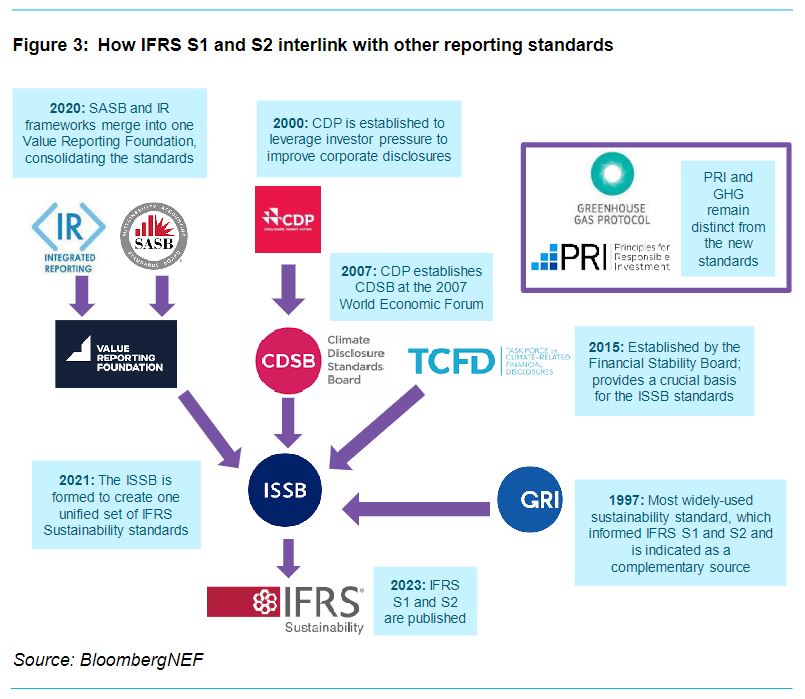Like every year, the 28th Conference of the Parties to the United Nations Framework Convention on Climate Change (COP28) was a blizzard of bold announcements, agreements, and pledges.
When sifting through the myriad things promised at any year’s COP, we always exercise cautious optimism. Agreements made during the conference are generally non-binding, commitments are only as good as the action that follows, and domestic and international dynamics can make progress difficult.
Still, this year’s COP was the largest yet, with more than 97,000 participants, many of whom were business representatives. Many announcements could impact how and when industry players decarbonize. This fact serves as a reminder that, along with international government agreements, cross-sector collaborations involving sub-national entities and private actors will continue to be powerful drivers of a swift transition away from the use of fossil fuels.
Where to Align Your Sustainability Agenda with COP28’s Outcomes
If an overarching theme emerged from COP28, it was the need for speed in reaching global climate targets. While the Global Stocktake revealed plenty of shared shortcomings in humans’ response to the climate crisis to date, it also uncovered progress made and areas of reasonable hope. But we must move much, much faster – and that will take everyone.
Corporate action dovetails with the many pledges made by governments and industry groups at COP28. Here are some ways your business can swim with the tide.
Energy
Predictably, renewable energy and energy efficiency commanded much of the spotlight at COP28. More than 120 countries pledged to, among many other things, “commit to put the principle of energy efficiency as the ’first fuel‘ at the core of policymaking, planning, and major investment decisions,” and to triple renewable energy and double energy efficiency by 2030. Additionally, 150 countries signed the targeting a 30% reduction of methane by 2030.
The U.S. led a group of new joiners to the Power Past Coal Alliance (PPCA), a coalition of governments, utilities, and grid operators formed to expedite the transition from coal power to clean power (an example of collaboration between state and non-state actors).
These national commitments imply changes to business operations in the years to come, and companies can avail themselves of a range of solutions to make impact. Our colleague Terence de Pentheny O’Kelly, VP of client solutions at Coho, explains in a recent article in Inc. Magazine:
“Combusting natural gas or petroleum products for heating and cooling or transportation has been core to almost every business’ ongoing operations; so how to shift away from that? The good news is that many electrified alternatives exist to those technologies—electric vehicles, air-source and ground-source heat pumps, electrified boilers, among others.”
Companies can also switch to clean electricity to harness more impact. O’Kelly says, “There are many pathways to procuring renewable energy in today’s market, with Virtual Power Purchase Agreements being the most ubiquitous thanks to their scale, availability and economic profiles.
“Organizations that pursue this one-two punch of electrification coupled with shifting to renewable electricity, create progress towards the COP’s latest agreement on three dimensions: reducing demand for fossil fuels, increasing demand for electricity and accelerating the electric grid’s transition from fossil-based generators to emissions-free electricity.”

Water
COP28 threw a much-needed spotlight on protecting global water resources. Many nations committed to include water targets in their Nationally Determined Contributions (NDCs) and National Adaptation Plans (NAPs).
A clear takeaway is that businesses must adopt sustainable water use practices, and fast. Managing climate and water goals in tandem will be important.
It’s critical for organizations to understand the link between water and energy—it takes water to produce energy, and it takes energy to use water. At COP28, the UN Water Expert Group, in collaboration with the International Universities Climate Alliance (IUCA), released preliminary research findings that quantify the water efficiency of different climate change mitigation measures. For example, biofuels use hundreds of times more water than geothermal to achieve the same emissions reductions.
As with your climate strategy, your corporation needs detailed data on water use across commercial and industrial systems. Once you begin reducing your carbon and water footprints, you should also be aware of the trade-offs that may exist.
Coho’s advisors can help identify solutions with simultaneous climate and water benefits.
Credible Net Zero Goals
Ahead of COP27 in 2022, UN Secretary-General António Guterres criticized the proliferation of hollow corporate net zero targets, urging participants to have “zero tolerance for greenwashing.” His remarks were made at the launch event for a UN report that provides clear guidance for credible net zero targets.
At COP28, officials reiterated these guidelines and expectations by launching the Net Zero Transition Charter. This initiative, established by the COP28 Presidency, asks companies to take the following steps:
Publicly set 1.5 degree aligned, science-based, credible, and transparent net zero 2050 and interim emissions reduction targets. This can be done through popular international initiatives like Race to Zero, 2050 Pathways, and Science Based Target Initiatives (SBTi).
Produce a credible net zero transition plan. Among other requirements, such plans name near- and long-term actions the company will take to lower its emissions in alignment with its governance and incentive structures, capital expenditures, research and development, skills and human resource development, and public policy advocacy.
Publicly report annual emissions and progress on their net zero commitment and transition plan.
It’s not clear what impact the Net Zero Transition Charter will actually have, but at a minimum, it reinforces the bar for credible net zero commitments. Coho and ERM can help your organization establish a net zero goal and transition plan that meet the standards outlined by this charter.
Reporting & Disclosure
It is encouraging to see more comprehensive measures emerging to promote accountability, knowledge sharing, and clarity. During COP28, nearly 400 organizations committed to using the reporting standards released earlier this year by the International Sustainability Standards Board (ISSB), International Financial Reporting Standards (IFRS) S1 and S2. Called the “Mother of All Standards” by BloombergNEF, these standards were designed to consolidate the “alphabet soup” of ESG reporting frameworks and finally provide a common sustainability language for companies and investors globally.
The European Union’s new ESG disclosure requirement, the Corporate Sustainability Reporting Directive (or CSRD), was also highlighted at the conference, with some new, extended deadlines in place to allow organizations in or doing significant business within the EU the chance to marshal resources for the process. (Read more in a new post by Coho analyst Vasilisa Gorbolskya.)
Other Notable Sector-Specific Outcomes
Food & Agriculture
Global agricultural practices will need to undergo a major transformation to keep up with the needs of the world’s growing population and to reduce the sector’s greenhouse gas emissions. COP28 participants discussed how to build sustainable food supply chains and mobilized more than $17B to help farmers adapt to the effects of climate change. They also committed to research and innovation that will help better distribute the burden of swiftly changing practices across the entire supply chain.
Shipping & Transportation
In a rare request for more, not less, regulation, the leaders of several major global shipping lines issued a joint declaration at COP 28 calling for an end date for building new fossil-only powered vessels and urging the International Maritime Organization (IMO), the global regulator, to accelerate the transition to green fuels with concrete policy measures that would underpin investment in maritime shipping and ancillary industries. The declaration lines out ambitious pledges from signees and requests member states and the IMO to join them by matching and supporting these actions.
The declaration also lays out the symbiotic relationship necessary between the shipping sector and green hydrogen producers to reach the stated goals. The rapid production, scale, and use of fuels such as ammonia and methanol will be critical, as well as the accompanying infrastructure—a scenario that will require significant collaboration and investment internationally.
The potential demand for green hydrogen created by the shipping sector’s markedly united stance on its transition away from fossil fuels “should encourage investment in … the necessary infrastructure. This in turn will help further incentivize the production of green hydrogen and hydrogen-derived fuels for use in shipping,” according to Rasmus Bach Nielsen, Global Head of Fuel Decarbonization for commodities and logistics group Trafigura. In the declaration, green hydrogen producers agreed to produce and provide 11 million tons of low-emissions fuel for use by the shipping sector by 2030. (In the years ahead, decarbonized global shipping could become one of the largest demand sources for green hydrogen, maybe as much as 15 % of total demand by 2050.)
Regulatory assistance from the IMO would not only strengthen compliance but offer confidence to investors interested in facilitating the transition of the shipping industry worldwide.
Heavy Industries
The COP28 Presidency, United Nations Climate Change, and Bloomberg Philanthropies launched the Industrial Transition Accelerator (ITA) to help heavy industry overcome challenges to decarbonization. The program will be housed at the Mission Possible Partnership, which has developed decarbonization strategies for sectors such as aluminum, cement, and steel. The ITA intends to “turbocharge” implementation of those strategies by driving market readiness (demand, investment, and favorable public policies) for technologies such as green hydrogen, longer duration storage, sustainable fuels, and carbon capture.
Complementing this movement, governments of the United States, Canada, Germany, and the United Kingdom signed the Green Public Procurement Pledge, committing to prioritize low- and near-zero-emission steel, cement, and concrete in public procurement. The pledge establishes a market demand for these materials through governments’ large purchasing power and creates opportunities for other businesses to follow suit. This is an important step towards mainstreaming the use of new technologies in heavy industries.
Dig Deeper
We’ve organized our own stocktake of some of the pledges and agreements from COP28 that we believe are likely to affect our community. Download our report for easy reference and further resources on what was said and done at this year’s COP.
The most economical, feasible, and impactful path to your own decarbonization will depend on your organization’s unique carbon footprint and business circumstances. Coho’s advisors can help you evaluate your options and craft a smart, actionable strategy. Get in touch to start a conversation.




